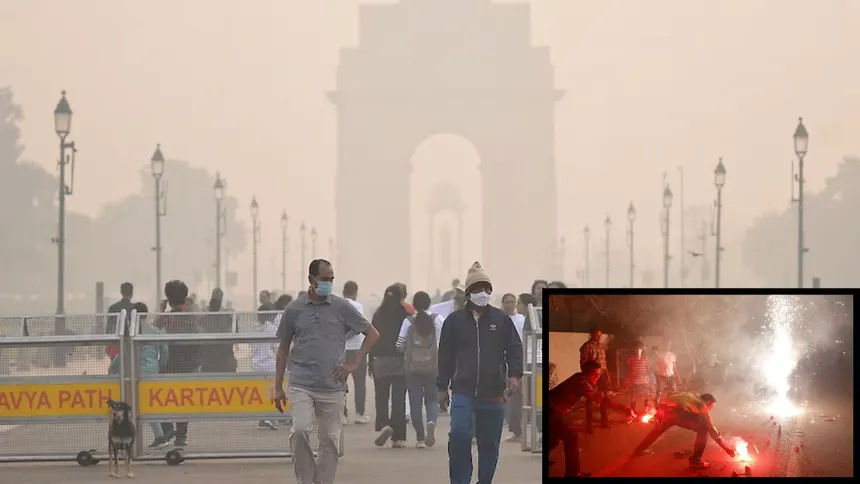Table of Contents
Introduction
Delhi air quality Diwali 2025 has plunged to alarming levels, with 36 of the city’s 38 monitoring stations entering the “red zone” just hours after festive fireworks lit up the sky. Four locations recorded an Air Quality Index (AQI) above 400 — classified as “severe” — turning Delhi into a smog-covered gas chamber once again. The toxic haze that followed the celebrations underscores the city’s persistent struggle between festive traditions and public health concerns.
This surge in pollution underscores a recurring problem: festive joy on one side, public health on the other.

What the numbers say
- The city’s average AQI early Tuesday morning was around 346. Moneycontrol+1
- Key hotspots:
- Wazirpur: 423 The Logical Indian
- Dwarka: 417 The Economic Times+1
- Anand Vihar: 404 Moneycontrol+1
- The city faced a thick blanket of smog, with visibility drastically reduced and many residents describing the air as toxic. The Indian Express+1
- The spike happened despite the Central Pollution Control Board (CPCB) permitting only “green” firecrackers between 8 pm and 10 pm. Moneycontrol
- These alarming statistics highlight how Delhi air quality Diwali 2025 became one of the worst in recent years, surpassing previous festival-day pollution peaks.
Why did this happen? Causes & contributing factors
1. Fireworks usage
The celebration with fireworks clearly pushed particulate matter (PM2.5 and PM10) and other pollutants skyward. Multiple reports note the correlation between post-Diwali firecracker bursting and the sharp AQI jump. The Logical Indian+1
2. Meteorological conditions
Stagnant air, low wind speeds and favourable conditions for accumulation meant pollutants weren’t dispersing. The Logical Indian+1
3. Other pollution sources
Beyond fireworks: transport emissions, industrial sources, dust, and crop stubble burning in neighbouring states (such as Punjab) also added to the load. Hindustan Times+1
4. Enforcement gaps
Even though the legal window and green cracker guidelines existed, enforcement appears to have been weak; firecrackers continued beyond permitted hours. Moneycontrol+1
Environmental experts note that Delhi air quality Diwali 2025 deterioration was mainly due to excess firecracker use combined with stagnant winter air.
Health & public-impact implications
- With AQI readings above 300-400, the air enters the “very poor” to “severe” category, posing serious health risks especially to children, the elderly, and those with respiratory conditions. The Indian Express+1
- Residents reported burning throats, difficulty breathing, and general distress after stepping out in the morning haze. The Indian Express
- The situation also carries a broader social cost: reduced visibility impacting transport, increased hospital visits, and heightened public anxiety.
- Doctors across NCR warn that Delhi air quality Diwali 2025 levels could lead to a spike in respiratory and cardiac issues over the next few days.
What are authorities doing / What should happen?
- The Commission for Air Quality Management (CAQM) reinstated Stage II of the Graded Response Action Plan (GRAP) across Delhi-NCR — restricting certain activities like construction, dust generation, and waste burning. The Economic Times+1
- Appeals to the public to reduce outdoor exposure, use masks and avoid bursting firecrackers after permitted hours.
- Longer-term: stricter enforcement of firecracker rules, shifts to cleaner transport, green buffers, and community awareness campaigns remain imperative.
- Authorities have re-activated emergency measures as Delhi air quality Diwali 2025 continues to remain in the red zone even 24 hours after Diwali night.
A call for collective responsibility
While policy and regulation are vital, transformation also depends on civic behaviour. The post-Diwali smog blanket is a recurring pattern that signals broader systemic issues—not just one festival’s fireworks. Communities, businesses, and individuals must reflect on habits and choices: celebration doesn’t have to come at the cost of the air we breathe.
Communities, businesses, and individuals must reflect on habits and choices: celebration doesn’t have to come at the cost of the air we breathe. To explore how Diwali traditions can coexist with sustainability, read our detailed piece on Diwali 2025 — Security, Environment, and Culture.
What you can do today
- Limit outdoor activity during early morning/late evening when pollution peaks.
- If you must be outside, wear an N95-type mask.
- Use indoor air purifiers or keep windows closed if air is very bad.
- Encourage neighbours/family to opt for minimal/no use of firecrackers, or use “green” certified ones strictly within permitted hours.
- Stay updated on AQI via apps/websites and plan accordingly.
Conclusion
The 2025 Diwali aftermath in Delhi serves as a stark reminder: just hours of fireworks can nullify months of progress in air-quality management. With 36 of 38 monitoring stations in the red and key areas registering AQI beyond 400, the city has once again confronted a familiar and alarming reality. It’s a moment to ask: can our festive lights shine without darkening our skies?
The crisis surrounding Delhi air quality Diwali 2025 serves as a yearly reminder of how critical it is to balance tradition with environmental health.









